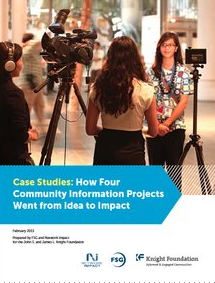
A paper town goes digital
When 30 percent of paper mill jobs were lost from 2000 to 2010 in Wisconsin’s rural south Wood County, it had more than just an economic impact.
Many corporations and executives left the area and residents who stayed had to scramble to find new jobs. The community faced new challenges in leadership and a shifting culture precisely when its information landscape was changing: local news was reduced to a single page in the Daily Tribune and television broadcasting rarely covered issues that mattered to its residents. RELATED LINK
The Incourage Community Foundation knew its residents would need more opportunities to provide relevant local information and help the community during its transition. After research revealed that more than a third of low-income families didn’t use the Internet, the foundation set aside initial plans to create an online news site and shifted its focus to facilitating civic dialogue and building better digital literacy. Knight recently talked with Kelly Ryan, Incourage’s President and CEO, to find out how its community changed in the process and what advice she’d give others embarking on similar work. What’s the one thing you’d tell community foundations embarking on this process? K.R.: Information investments are vital in broad scale community change efforts. As grantmakers, we know instinctively that data, research and evaluation matter. What we’re not so good at knowing or seeking to understand is the ‘information culture’ that exists in our communities. How does information flow and to whom? Who has access to information? What are the barriers to access? If access is not an issue, do residents have the capacity to utilize information effectively? How do we help residents turn knowledge into action? It is long-term work that requires humility, learning, reflection and perseverance. One cannot do it effectively without understanding power dynamics, culture, networks and systems change strategies. It is difficult, sometimes ambiguous work – but absolutely essential to creating vibrant, prosperous communities that work for all people. You used the Knight Commission Report on the Information Needs of Communities in a Democracy. Was it valuable? How so? K.R.: We began using the Knight Commission Report Informing Communities: Sustaining Democracy in a Digital Age for guidance when it was still in its draft form in 2009 and continue to use it today. The guiding principles of ‘access, capacity and engagement’ as they relate to creating a healthy community information system have been central to our work and are vital to any community change strategy. The report continues to be relevant and we distribute it liberally – local, regional and state leaders, elected officials, interested citizens – have all benefited from a deeper and nuanced understanding of this issue. It is so vitally important to all of us who seek to build strong communities. Further, we experimented early on with some of the checklists and appendix items included in the report which helped to inform the creation of a very user-friendly Community Information Toolkit. The toolkit is a great resource for those just beginning to explore and understand the information needs of their respective community. If you could go back and change one thing along the way, what would it be? K.R.: Understanding that it’s not enough to work on the supply side of information. Our immediate thought when we learned of the first Knight Community Information Challenge opportunity was to create an online news source to augment what had been lost in terms of coverage within the local newspaper. We quickly came to understand that we didn’t know the ‘information culture’ within our community and needed to understand issues of not only access, but also capacity and engagement. Our work today incorporates a much deeper understanding and focus on increasing the appetite for and use of accurate, timely and relevant information. How has your community changed through this process? K.R.: Our residents are increasingly seeing themselves as agents of change. We are beginning to understand and discuss power, realize the importance of civic engagement and appreciate the need to shape a new culture and social norms in the region. We see evidence of this in the following ways:
- Response to our community-wide survey, in which over 1,500 residents stated that they want to engage in community change.
- Response to our first community organizing training, in which 40 individuals were introduced to the principles of community organizing.
- Our 24-year old Mayor’s interest in creating a variety of mechanisms that will help residents engage in the public process, along with his commitment to transparency in government – including a first ever State of the City address.
- Organizations and initiatives increasingly using collective approaches to issues or opportunities in the community, with intentional inclusion of understanding information as part of their strategy.
- Our own institutional change, predominantly through a thorough analysis of our organization’s governance model; asking ourselves ‘how do we incorporate a grassroots model that authentically includes resident voice in the deliberations and decision-making of the foundation itself?’
Read more in “How Four Community Information Projects Went from Idea to Impact.” By Elizabeth R. Miller, communications associate at Knight Foundation Related: “Nine insights on taking community information projects from idea to impact” by Mayur Patel on KnightBlog
Recent Content
-
Communitiesarticle ·
-
Communitiesarticle ·
-
Communitiesarticle ·



